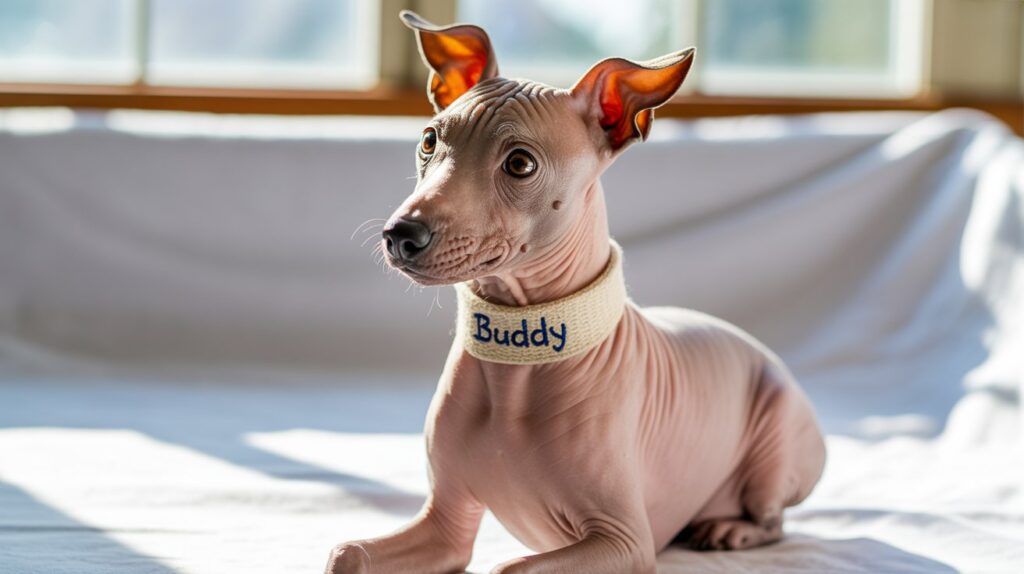Table of Contents
- Introduction: Meet the Unique American Hairless Terrier
- A Brief History: From Rat Terrier to Hairless Wonder
- The “No Fur” Advantage: More Than Just Looks
- A Shed-Free Home Environment
- Beating the Heat: Reduced Risk of Overheating
- Are American Hairless Terriers Hypoallergenic?
- Temperament and Personality: A Big Dog in a Small, Smooth Body
- Intelligence and Trainability
- Energy Levels and Exercise Needs
- Compatibility with Families and Other Pets
- Caring for a Coat-Free Canine
- Essential Skincare Regimen
- Bathing and Moisturising
- Sun Protection: A Must for Hairless Skin
- Staying Warm in Cooler Climates
- Health and Lifespan
- Conclusion: Is the American Hairless Terrier Right for You?
- Frequently Asked Questions (FAQs)
Introduction: Meet the Unique American Hairless Terrier
Imagine a dog that combines the spirited, playful nature of a terrier with the unparalleled benefit of having absolutely no fur. Meet the American Hairless Terrier (AHT), a remarkable and relatively new breed that is rapidly gaining popularity for its unique characteristics. For many potential dog owners, the idea of a life free from constant vacuuming and lint rollers is a dream come true. The AHT offers just that, but the advantages of its hairless state go far beyond just a clean house. This breed’s lack of a coat means virtually no shedding and a significantly reduced risk of overheating in warmer climates, making them a fascinating and practical choice for many households.

A Brief History: From Rat Terrier to Hairless Wonder
The story of the American Hairless Terrier is a perfect example of a happy accident. The breed’s origins trace back to a single litter of Rat Terriers born in Louisiana in 1972. Within this litter was one completely hairless female puppy, whom the owners named Josephine. Charmed by her unique appearance and sweet nature, her owners, Edwin and Willie Scott, decided to embark on a breeding programme.
For over a decade, they worked to reproduce this hairless trait, and their efforts eventually paid off, establishing the foundation for the American Hairless Terrier. It’s important to note that unlike some other hairless breeds, the AHT’s hairlessness is caused by a recessive gene, meaning they do not suffer from the dental and skin issues sometimes associated with dominant hairless genes. They were officially recognised by the American Kennel Club (AKC) in 2016, cementing their place in the canine world.
The “No Fur” Advantage: More Than Just Looks
While their smooth skin is their most striking feature, the benefits of being hairless are what truly set the AHT apart.
A Shed-Free Home Environment
The most obvious perk is the complete lack of shedding. For individuals who are meticulous about cleanliness or simply tired of dog hair clinging to every surface, the American Hairless Terrier is a game-changer. There’s no fur to embed itself in carpets, furniture, or clothing. This means less time cleaning and more time enjoying your companion.
Beating the Heat: Reduced Risk of Overheating
Dogs primarily cool themselves by panting, but a thick fur coat can trap a significant amount of heat, making them susceptible to overheating, especially during hot and humid weather. The American Hairless Terrier, with its bare skin, can dissipate body heat much more efficiently. This gives them a distinct advantage in warmer climates, as they face a lower risk of heatstroke. However, this doesn’t mean they are immune; they still need access to shade and water, and their skin needs protection from the sun.
Are American Hairless Terriers Hypoallergenic?
This is a common question, and the answer is nuanced. No dog is 100% hypoallergenic. Allergies are often triggered by dander (dead skin cells), saliva, and urine, not just hair. However, because the AHT has no fur to trap and shed dander around the house, many people with mild to moderate dog allergies find they can live comfortably with this breed. The dander doesn’t become airborne as easily, drastically reducing the allergen load in the environment.
Temperament and Personality: A Big Dog in a Small, Smooth Body
Beneath their unique exterior lies a classic terrier heart. The AHT is intelligent, energetic, and incredibly affectionate. They form strong bonds with their families and thrive on being part of the action.
Intelligence and Trainability
Inheriting the sharp mind of their Rat Terrier ancestors, AHTs are clever and quick to learn. They excel in positive reinforcement training and are eager to please their owners. This intelligence, combined with their playful nature, makes them strong candidates for dog sports like agility, obedience, and rally.
Energy Levels and Exercise Needs
Don’t let their small size fool you; these are active dogs. They require regular daily exercise to stay physically and mentally stimulated. A brisk walk, a game of fetch in a fenced yard, or puzzle toys are excellent ways to burn off their terrier energy. A bored AHT can become mischievous, so keeping them engaged is key.
Compatibility with Families and Other Pets
American Hairless Terriers are known for being wonderful family pets. They are generally good with children, especially when raised with them. Their playful and loving nature makes them great companions for all ages. As with any terrier, they may have a prey drive, so early socialisation with cats and other small animals is crucial for a harmonious household.
Caring for a Coat-Free Canine
Caring for an AHT is different from caring for a coated breed. You trade grooming brushes for sunscreen and moisturisers.
Essential Skincare Regimen
The skin is their largest organ and their first line of defence. It’s prone to the same issues as human skin, including acne (especially during adolescence), dryness, and sunburn. Regular inspection of their skin is important to catch any potential issues early.
Bathing and Moisturising
Unlike furry dogs that can go weeks between baths, an AHT needs more frequent bathing—typically once a week or every few weeks—to remove the build-up of skin oils and dirt. Use a gentle, dog-specific shampoo. After bathing, it’s often necessary to apply a mild, non-comedogenic (non-pore-clogging) moisturiser to keep their skin soft and prevent it from drying out.
Sun Protection: A Must for Hairless Skin
Their lack of fur means they have no natural protection from the sun’s harmful UV rays. Sunburn is a real and dangerous risk. When outdoors for extended periods, you must apply a dog-safe sunscreen to their skin, particularly on light-coloured dogs. Providing shady spots and considering protective clothing like a light t-shirt or sun-suit is also highly recommended.
Staying Warm in Cooler Climates
The same trait that helps them in the heat makes them vulnerable to the cold. American Hairless Terriers do not have a coat to insulate them. In chilly weather, they will need protective apparel like sweaters, coats, and even boots to stay warm and comfortable during walks.
Health and Lifespan
The American Hairless Terrier is generally a healthy breed with an impressive lifespan of 14 to 16 years. Because their hairlessness is due to a recessive gene, they avoid many of the health problems linked to dominant hairless genes in other breeds. Responsible breeders will screen their breeding stock for conditions like patellar luxation, Legg-Calve-Perthes disease, and cardiac issues to ensure the health of their litters.
Conclusion: Is the American Hairless Terrier Right for You?
The American Hairless Terrier offers a unique proposition: all the love, intelligence, and spirit of a terrier with none of the shedding. Their lack of fur makes them ideal for neat-freaks, a strong contender for many allergy sufferers, and better suited for life in warmer climates due to a reduced risk of overheating. However, prospective owners must be prepared for a dedicated skincare routine that includes regular bathing, moisturising, and diligent sun protection. If you’re looking for an energetic, loyal, and truly one-of-a-kind companion and are ready to embrace their special care needs, the AHT could be the perfect dog to complete your family.
Frequently Asked Questions (FAQs)
Q1: Do American Hairless Terriers get pimples? Yes, it is common for AHTs, especially during their “teenage” months, to develop acne or pimples. Regular bathing with a gentle shampoo can help manage this. You should never pop the pimples, as it can lead to infection and scarring.
Q2: Are AHTs noisy dogs? Like most terriers, they can be prone to barking, especially to alert their owners of something new or unusual. Early training and socialisation can help manage this tendency.
Q3: How much does an American Hairless Terrier cost? The price for a puppy from a reputable breeder can vary significantly based on location, lineage, and breeder reputation, but you can generally expect to pay between $1,500 and $2,500.
Q4: Is there a coated variety of the American Hairless Terrier? Yes! Because the hairless gene is recessive, litters can produce both hairless and coated puppies. The coated variety has a short, fine coat and is recognised as a separate variety by the AKC. They still shed very little compared to other breeds.
Q5: Do they need special bedding? AHTs love to burrow and snuggle to stay warm. Providing soft blankets, covered beds, or “snuggle sacks” is highly recommended and will be greatly appreciated by your hairless friend, especially in the winter.
